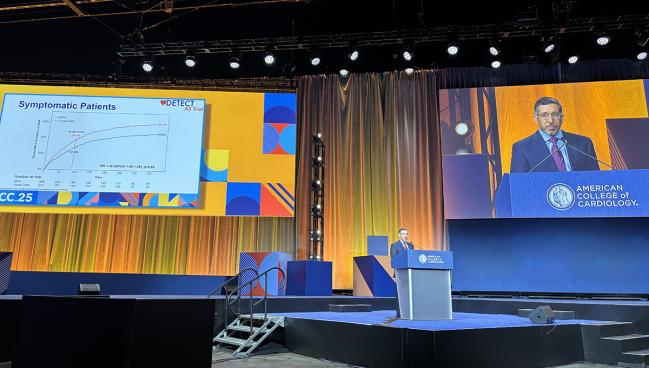DETECT-AS: Alert System Increase AV Replacement in Eligible Patients
The “passive” notification led to more patients with severe AS undergoing valve replacement, but more can be done still.

CHICAGO, IL—A personalized alert system that informs healthcare providers about the detection of severe aortic stenosis on echocardiography and provides recommendations around patient management appears to improve the quality of aortic valve care, according to results from the DETECT-AS study.
Presented earlier this week at the American College of Cardiology (ACC) 2025 Scientific Session and published simultaneously in Circulation, the study showed the alert increased the rate of aortic valve replacement (AVR) and reduced treatment disparities, including in elderly patients and women, when compared with usual care.
“As these sorts of decision support tools become prevalent in the electronic health record, I do worry about alert fatigue given the fact that everybody's going to advocate for an alert for their disease process,” said senior investigator Sammy Elmariah, MD, PhD (University of California, San Francisco), during the late-breaking clinical trial session. “We have to be very thoughtful as a community in terms of determining the highest need and highest priority health conditions that warrant them. In our study, we did evaluate whether there was any degree of fatigue, but impact of the tool actually seemed to increase with time as opposed to the opposite, which was very reassuring.”
In 2023, the American Heart Association (AHA) launched Target Aortic Stenosis, a national initiative to improve quality of care and outcomes of patients with aortic stenosis. The AHA/ACC also published, in 2024, clinical performance and quality measures for adults with valvular and structural heart disease. One of the key metrics identified by the AHA/ACC, said Elmariah, is the percentage of patients undergoing AVR for symptomatic severe aortic stenosis within 90 days of the diagnosis.
“There is clear unmet need for effective, low-cost, and scalable tools to bolster guideline-driven management of severe aortic stenosis,” he said.
Electronic Alerts via EMR and Email
DETECT-AS was a pragmatic, single-blinded, cluster randomized trial conducted within the Massachusetts General Hospital academic health system between 2022 and 2023. Patients with severe aortic stenosis on transthoracic echocardiography (TTE) were screened for enrollment and, after it was confirmed they was eligible for the study (aortic valve area of 1.0 cm2 or less on TTE), their clinicians were randomly assigned to the intervention or control group.
For the intervention group, 144 clinicians enrolling 496 patients were sent a notification via the electronic medical record (EMR) and email highlighting the detection of severe or potentially severe aortic stenosis. The type of aortic stenosis was clarified by subtype (based on mean aortic valve gradient and LVEF) and guideline-based recommendations for management and further evaluation were provided. In the usual care arm, there were 141 providers with 443 patients.
“Four versions of the notifications were generated based on thresholds for mean valve gradients and left ventricular ejection fraction,” said Elmariah. “This allowed us to customize recommendations in the notification to not only summarize or highlight the detection of aortic stenosis, but also to provide specific guideline-based recommendations for further diagnostic testing, for referral, and for treatment where appropriate.”
Among the clinicians, 3.9% were cardiac surgeons or interventional cardiologists, 47.7% were general cardiologists, 33.3% were primary-care physicians, and 15.1% were other specialists. Among patients, the mean age was 77.3 years and 47% were female. The mean aortic valve area, aortic valve gradient, and LVEF was 0.8 cm2, 36 mm Hg, and 62%, respectively.
The rate of AVR at 1 year, the study’s primary endpoint, was significantly higher with the electronic notification than with usual care (48.2 vs 37.2%; P = 0.009). In symptomatic patients, more than 60% underwent valve replacement by 1 year compared with 47% in the usual care group (P = 0.001)
Within 90 days of TTE, 25.8% of patients in the electronic notification arm underwent AVR compared with 19.0% in the usual-care group (P = 0.02). Among symptomatic patients, the respective 90-day rates were 37.7% and 26.6% in the intervention and usual-care groups (P = 0.04). The alert led to higher rates of valve replacement at 1 year in all subgroups, but the gains were more pronounced in patients older than 80 years and in women.
The study wasn’t powered for survival and there was no differences between the two groups at 1 year. In the symptomatic patients, “there was a strong trend suggesting prolonged survival in patients being cared for by notified providers,” said Elmariah. There was no difference in hospitalizations for HF, but the alert did lead to more patients receiving an ICD-10 billing code indicative of clinically recognized aortic stenosis at both 90 and 180 days.
Among primary-care physicians and other noncardiologists, a cardiology referral was more common when clinicians received the alert than it was with usual care (63.4% vs 39.5%; P = 0.004). Similarly, cardiologists who received the alert were more likely to refer to valve specialists, although the difference wasn’t statistically significant (41.2% vs 34.3% with usual care; P = 0.09). Repeat TTE within 1 year of the index echo was also more common in clinicians who received the electronic notification.
Still Not Getting Symptomatic Patients Care
During the ACC session, Elmariah said the results might not be generalizable to less integrated health care systems. He also noted that providers may have become aware of the ongoing trial, which could have influenced their referral patterns. Still, he said the inclusion of asymptomatic patients, as well as those with pseudosevere aortic stenosis—a group without an indication for AVR—possibly underestimated the efficacy of the electronic notification.
Although it is simply a passive alert sent to the physician’s inbox or EMR, the researchers observed “robust improvement” in referrals for aortic valve replacement by 1 year, he said.
“But we are still only treating 60% of patients with symptomatic severe stenosis at 1 year,” said Elmariah. “We’re nowhere close to getting the types of results in 90 days” advocated by the AHA and ACC with their initiatives. As a result, an alert that is a little more robust may be needed.
“I think the next step is to have an alert that forces providers to act, or to at least facilitate referrals,” he said. Such an alert would allow providers to maintain control of that referral process so they can turn down or reject a referral if it is clinically not appropriate, “but at the same time provides a safety net that mitigates patients falling through the cracks.”
Srinath Adusumalli, MD (University of Pennsylvania Perelman School of Medicine, Philadelphia), who was part of the late-breaking session’s panel discussion, asked if the researchers workshopped the language and/or framing in the notification. Elmariah said they hadn’t as they didn’t want word of the Institutional Review Board-approved study, which was exempt from consenting physicians, from leaking out and altering behaviors.
Michael O’Riordan is the Managing Editor for TCTMD. He completed his undergraduate degrees at Queen’s University in Kingston, ON, and…
Read Full BioSources
Tanguturi V, Abou-Karam R, Cheng F, et al. Electronic provider notification to facilitate the recognition and management of severe aortic stenosis: a randomized clinical trial. Circulation. 2025;Epub ahead of print.
Disclosures
- Edwards Lifesciences funded DETECT-AS.
- Elmariah reports research grants from the National Institutes of Health, Patient-Centered Outcomes Research Institute, Edwards Lifesciences, Abbott Vascular, and Medtronic; consulting fees from Edwards Lifesciences; and equity in Prospect Health.





Comments